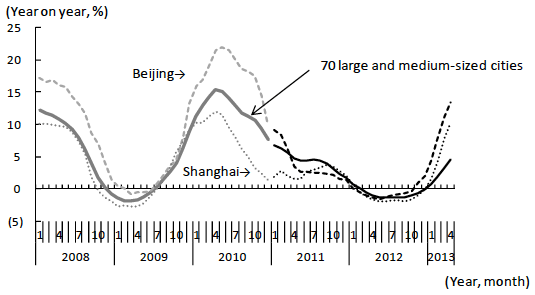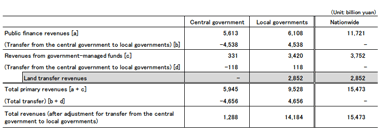Since 2010, the Chinese government has launched a series of policies—aimed primarily at curbing demand—to control the rise in housing prices. However, as the policies are simply makeshift measures, more radical steps to increase land supply are required through reforms to the existing land system.
The real estate bubble is back
In China, the real estate market has shown signs of a bubble, as indicated by the steep rise in housing prices in major cities, following monetary easing policies in the wake of the collapse of Lehman Brothers. This phenomenon is particularly noticeable in large cities in the coastal areas. In 2011, the sales price of a standard home (70 square meters) in Beijing and Shanghai rose to a level 22.3 times and 15.9 times higher than the average household income, respectively, and is significantly larger than the level in Tokyo, which is 10.0 times higher than the average household income (IMF, 2012). As a result, the Chinese people are feeling growing frustration as their dream of owning a home becomes more remote. If the housing bubble balloons further, it could also have a serious impact on the banking sector and the macro economy when it bursts.
To avoid this consequence, the Chinese government has been announcing and implementing a series of policies since 2010. Major steps to control demand include restrictions on loans, limits on purchases, and a hike in real estate-related taxes, while the primary measure to increase supply is to accelerate the construction of social security housing for low-income groups. Thanks also to the shift toward credit tightening, the year-on-year rate of increase in sales prices of newly constructed residential buildings in 70 large and medium-sized cities remained negative for 10 consecutive months since March 2012. However, since January 2013, it has turned positive once again, following the resumption of monetary easing (Figure 1). In April 2013, sales prices of newly constructed residential buildings in 70 large and medium-sized cities rose 4.5% year on year, and the rate of increase was particularly high in large cities such as Beijing and Shanghai, where prices rose 13.4% and 10.2%, respectively.

Price Indices of Newly Constructed Commercial Residential Buildings from January 2011. 70 large and medium-sized cities is the simple average.
Land policies that encouraged the real estate bubble
The real estate bubble in essence is a land bubble. In China, local governments monopolize land supply and control the land market and prices. Farmers are prohibited from freely selling the land they use to developers, and can only sell it to local governments at low prices when being "expropriated."
On the other hand, local governments are able to sell the land purchased from farmers to developers at high prices through auctions and other means (Note). As the difference is a source of revenue for local governments, this serves as an incentive for them to maintain high land prices. However, it also raises the costs for developers, and real estate prices consequently rise.
In addition, the government has adopted a policy of maintaining farmland of 1.8 billion mu (120 million hectares) to sustain the self-sufficiency rate for food. As a result, the conversion of farmland to other uses has made little progress, and the supply of land necessary for urbanization is severely hampered. This further reinforces the escalation of land and real estate prices.
Desired changes in land policies
To control land prices, the government must solve these problems by implementing the following policies.
First, land ownership must be clarified. Although privatization is the ideal way, it is unlikely given ideological constraints. As a second-best solution, the government should extend the term of the right to use land. In addition, there should be no differentiation with respect to the right to use land among the governments, collectives, companies, and individuals, so that trading land on the market can be accessible to anyone. This would bring land prices down to their fair value, and the real estate bubble would be eliminated.
In addition, the policy of maintaining farmland of 1.8 billion mu should be ended. The potential farmland shortage issue as a result of this deregulation should be resolved by consolidating land for farming and increasing the productivity of agriculture.
Furthermore, local governments must secure new sources of revenues that will replace revenues from selling land (hereinafter "land transfer revenues"). As a result of the higher proportion of tax revenues going to the central government following the tax reforms of the 1990s, local governments have become increasingly dependent on land transfer revenues and borrowings through financing platform companies to secure funds needed for infrastructure construction.
Land transfer revenues have already become an important revenue source for local governments (Table 1). Total revenues of local governments consist of "public finance revenues," mainly from taxes (equivalent to revenues in the general account in Japan), "revenues from government-managed funds" (equivalent to revenues in the special account in Japan), and the fiscal transfer from the central government. Land transfer revenues are classified as "revenues from government-managed funds" and account for a high proportion of total revenues. In 2012, land transfer revenues reached 2,852 billion yuan. This represents 20.1% of the total revenues of local governments (14,184 billion yuan) and 29.9% of the "primary revenues" (9,528 billion yuan) that exclude the fiscal transfer from the central government. Combined with real estate-related tax revenues, the scale of "land finance" in a broad sense will be even greater. According to the Ministry of Finance, total revenues in 2012 from urban and suburban land use taxes, land appreciation tax, real property tax (fang-chan-shui in Chinese, a type of real estate tax), farming land occupation tax, and deed tax reached 1,013 billion yuan ("Status of Fiscal Balance 2012" and "Analysis on Structure of Increasing Tax Revenues 2012").
 [Click to enlarge]
[Click to enlarge]However, with revenues decreasing as land sales become difficult following measures by the central government to control real estate prices and expenditures expanding as public works such as the construction of housing for low and medium income earners increases, local government are facing an increasing number of serious fiscal problems. To secure revenue for them, more radical measures such as an adjustment of the ratio of tax revenues between the central government and local governments, and, at the same time, the full-scale implementation of a real property tax on residential housing for individuals (already tested in Shanghai and Chongqing) should be accelerated, ending the dependence on land transfer revenues.


